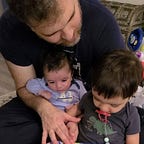Witnessing The Joys Of Learning
Lessons from M taking baby steps
My younger M started walking a couple of weeks ago. As much as the joy we have in parents in watching our children walk I noticed the smile on his face. This one year old knew he was crossing a huge achievement milestone. So I wanted to think back on what I observed about his learning and see what lessons we can learn about learning itself.
Standing Up — He learned to stand up by himself a few weeks before he started walking. He definitely appreciated it. But I don’t quite remember the same kind of joy on his face as when he started walking. But it was a means to an end. Trying to get up, flopping down, making your way to more controlled falling down.
It reminded me of something I learned from humankind’s quest to soar. Hmm, hmm, what to do. Do I present myself as accessible everyman by giving the example of watching “Mr Monk Goes To The Circus” that the first thing trapeze artists learn is to fall. Or do I talk about that keynote I attended at Data Day where the speaker told the story of human powered flight. Okay let’s pretend I’m not a couch potato. In the mid-90s the Royal Aeronautical Society offered the Kremer prize for achieving controlled sustained flight by a human powered aircraft. Most teams would spend months designing and building an aircraft. Then they’d try to fly it, crash, and go back to the drawing board. One of the teams decided that well, we’re mostly spending our time crashing and building. So why don’t we design something that we can rebuild quickly after a crash. And with this ability to quickly do experiments they were able to win the Kremer prize.
So whether it’s learning to walk or fly, when going on a new endeavor it is essential to make sure you put yourself in a position where you can experiment safely.
What’s funny is that our older R learned to crawl after walking for a few days. So even though he did not focus on safety first. After doing a proof of concept with walking and locomotion he decided it’s worth doing but he needed to build out the experimentation platform first. So both of them with their own different paths chose the same principle.
Look I’m walking — After a couple of weeks M took a few steps and promptly fell down. But he knew what he had just accomplished. Over the next couple of days he kept on trying it again. And each time he had a look of pure joy. Proudly exclaiming to the world, look I can do this. Take a few steps, then fall. Take a few steps, then fall. It didn’t matter that probably crawling would be faster and definitely less painful, it was still a moment to be celebrated.
And so when you start on a new art, new skill, new technique, new technology. You need to a) Celebrate the successes you have b) Value the work for its potential not where you are right now.
One of the best parts about him starting to walk and fall is now I can encourage him one of my favorite Urdu couplets.
Translated:
Cavalrymen fall in the battlefield
What would the crawling infant fall
And while I say it jokingly there is a certain truth to it. Once you’ve established that you can experiment safely. It’s time to step outside your comfort zone and start having safe failures.
Kaizen — After learning to walk starts the process of continuous improvement. There are two types of developments
- Improving your current techniques. This involved him walking further for longer and becoming more stable.
- Adding new techniques to the toolkit. The most important development in this was when he started taking turns while walking.
Both of these are necessary. And so as you’re learning a new skill it’s important to think about both perfecting what you already know and acquiring adjacent skills to unlock the value of what you already know.
Applying Your Skills — M has already started applying his skills. Obviously it is his preferred form of locomotion now. But beyond that he’s taking these skills to outside exploration and to dancing with his brother to “Wheels On The Bus Go Round And Round”
So take what you know, and apply to new domains and use-cases. It will help you both in perfecting your skill in your current domain and also open up more opportunities in other domains.
Takeaway
After observing M learning to walk I can confidently say one thing. Children are amazing empiricists and we should strive to be more like them rather than molding them to be more like us.
